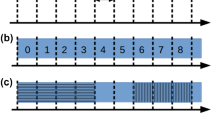Abstract
In this paper, we consider a fiber routing problem arising from the design of optical transport networks. The problem is to find an optimal routing of multiple rings and an optimal location of wavelength division multiplexed (WDM) systems for carrying demand traffic. This problem can be conceptualized as a Steiner (multiple) ring problem with link capacity constraints. We formulate the problem as a mixed-integer programming model and develop a new branch-and-cut procedure along with preprocessing routines and valid inequalities for optimally solving the problem. Exploiting the inherent special structures of the formulation, we focus on developing strong valid inequalities and devising an effective Tabu search heuristic for solving large-scale problems. Computational results indicate that preprocessing rules and valid inequalities provide a tight lower bound, and in turn reduce the effort required to solve the problem within the framework of the branch-and-cut procedure. Moreover, the proposed Tabu search heuristic works quite well for solving large-scale problems. Motivated by promising computational results, we provide insights into implementing the proposed branch-and-cut procedure for deploying fiber optic networks in practice.
Similar content being viewed by others
References
E. Balas, The prize collecting traveling salesman problem, Networks, vol. 19, (1989), pp. 621-636.
P. Bonenfant, C. Newton, K. Sparks, E. Varma, R. Alferness, A practical vision for optical transport networking, (White Paper Optical Networking Group, Lucent Technologies 1999).
CPLEX, Using the CPLEX callable library version 7.0, (ILOG, 2001).
M. Gendreau, G. Laporte, F. Semet, The covering tour problem, Operations Research, vol. 4, (1997), pp. 568-576.
F. Glover, Future paths for integer programming and links to artificial intelligence, Computers and Operations Research, vol. 5, (1986), pp. 533-549.
F. Glover, M. Laguna, Tabu Search (Kluwer Academic Publishers, 1997).
E. Karasan, E. Ayanoglu, Effects of wavelength routing and selection algorithm on wavelength conversion gain in WDM optical networks, IEEE/ACM Trans. on Networking, vol. 2, (1998), pp. 186-196.
M. Kuznetsov, et al. A next-generation optical regional access network, IEEE Comm. Mag., vol. 1, (2000), pp. 66-72.
Y. H. Lee, H. D. Sherali, J. H. Han, S. I. Kim, A branch-and-cut algorithm for solving an intra-ring synchronous optical network design problem, Networks, vol. 35, (2000), pp. 223-232.
Y. H. Lee, J. H. Han, S. I. Kim, A physical ring design problem of synchronous optical networks for mass market multimedia telecommunication services, INFORMS National Meeting, Philadelphia, USA, (Nov. 7–10, 1999) p.72.
M. Padberg, G. Rinaldi, A branch-and-cut algorithm for the resolution of large-scale symmetric traveling salesman problem, SIAM Review, vol. 33, (1991), pp. 60-100.
R. Ramaswami, K. N. Sivarajan, Optical Networks: A Practical Perspective (Morgan Kaufmann, California, 1998).
T.-H. Wu, Fiber Network Service Survivability: Architecture, Technologies, and Design (Artech House, 1992).
Author information
Authors and Affiliations
Rights and permissions
About this article
Cite this article
Lee, Y., Han, J. & Kang, K. A Fiber Routing Problem in Designing Optical Transport Networks with Wavelength Division Multiplexed Systems. Photonic Network Communications 5, 247–257 (2003). https://doi.org/10.1023/A:1023040219593
Issue Date:
DOI: https://doi.org/10.1023/A:1023040219593




